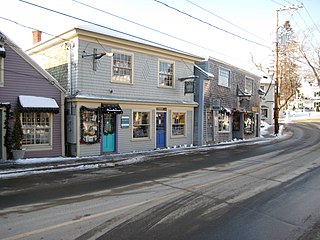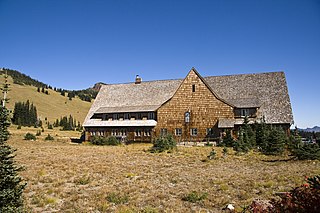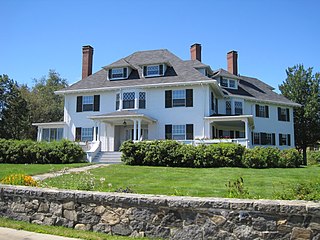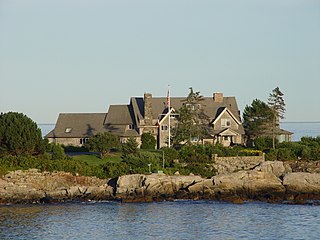
The Bellevue Avenue Historic District is located along and around Bellevue Avenue in Newport, Rhode Island, United States. Its property is almost exclusively residential, including many of the Gilded Age mansions built by affluent summer vacationers in the city around the turn of the 20th century, including the Vanderbilt family and Astor family. Many of the homes represent pioneering work in the architectural styles of the time by major American architects.

The Cape May Historic District is an area of 380 acres (1.5 km2) with over 600 buildings in the resort town of Cape May, Cape May County, New Jersey. The city claims to be America's first seaside resort and has numerous buildings in the Late Victorian style, including the Eclectic, Stick, and Shingle styles, as well as the later Bungalow style, many with gingerbread trim. According to National Park Service architectural historian Carolyn Pitts, "Cape May has one of the largest collections of late 19th century frame buildings left in the United States... that give it a homogeneous architectural character, a kind of textbook of vernacular American building."

The Wianno Historic District is a historic district in the Osterville section of Barnstable, Massachusetts. It encompasses a well-preserved summer resort area for the wealthy that was first developed in the late 19th century, focused around the Wianno Club, built in 1881 on the site of an earlier resort hotel. The 40-acre (16 ha) district has a significant number of well-preserved Shingle style and Colonial Revival houses. Architect Horace Frazer designed the Wianno Club, as well as a number of the private residences in the district. The district is roughly bounded by East Bay Road, Wianno and Sea View Avenues between Nantucket Sound and Crystal Lake. It was added to the National Register of Historic Places in 1987.

The Hyannis Port Historic District encompasses the historic heart of Hyannis Port, Massachusetts, an area that was intensively developed as a summer resort community beginning in the later decades of the 19th century. The district is about 100 acres (40 ha) in size, and extends from nearly Scudder Avenue in the west to Ocean Avenue in the east. It is bounded on the south by Nantucket Sound, and on the north by Grayton, Edge Hill, and Ocean Avenues. The district was added to the National Register of Historic Places in 1987.

The Beaver Hills Historic District is a 97-acre (39 ha) historic district in the Beaver Hills neighborhood of New Haven, Connecticut. It was listed on the National Register of Historic Places in 1986. In 1986, it included 235 contributing buildings.

The Shelburne Hotel was a resort in Atlantic City, New Jersey located at Michigan Avenue and the Boardwalk. Built and opened in 1869, the hotel was originally a wood-frame cottage. Following several expansions, under the direction of hotel manager Jacob Weikel, a modern, brick-faced, steel frame, multistory structure was constructed along Michigan Avenue at the corner with the Boardwalk. This portion of the hotel opened in 1926. The hotel was an example of Georgian Revival architecture and was listed on the National Register of Historic Places in 1978.

St. Peter's By-The-Sea Protestant Episcopal Church is a historic church at 529 Shore Road in York County, Maine, approximately 1 mile north of the village of Cape Neddick. Built in 1897, it is fine example of Gothic Revival architecture, and as one of several architecturally distinguished summer resort chapels that dot the Maine coast. It was listed on the National Register of Historic Places in 1999. It is used for services between June and September.

The York Historic District encompasses the historic village center of York, Maine, one of the oldest communities in the state. The expansive 1,700-acre (690 ha) district includes the oldest church in Maine, built by its oldest congregation in 1747, and the Old York Gaol, a National Historic Landmark that is one of the oldest public buildings in the United States. The district was listed on the National Register of Historic Places in 1973.

The Kennebunkport Historic District encompasses most of the village center of Kennebunkport, Maine. It includes the town's highest concentration of historic architecture, with many buildings from the late 18th and early 19th century, when Kennebunkport was at its height as a shipping and shipbuilding center. The district was added to the National Register of Historic Places on May 6, 1976.

The Strathglass Park District, located in Rumford, Maine, encompasses one of the nation's finest early 20th-century mill worker housing complexes. Funded by Hugh J. Chisholm, owner of Rumford's paper mill, and designed by Cass Gilbert, the district encompasses a collection of 50 high quality brick duplexes, of similar yet varied construction, which were built in 1901-2 on a series of tree-lined streets, with a small park at the center. As of the district's listing on the National Register of Historic Places in 1974, only one of the Gilbert-designed houses had been destroyed. The company divested itself of the houses in the late 1940s, with most being sold to their occupants.

The Sunrise Historic District, also known as the community of Sunrise, Washington, is located at approximately 6,400 feet (2,000 m) on a ridge overlooking the northeast side of Mount Rainier in Mount Rainier National Park. The district comprises seven individual structures designed in accordance with the principles of the National Park Service Rustic style. The area is inhabited and open to the public only during a brief period in the summer season.

Manitou Springs Historic District in Manitou Springs, Colorado is roughly bounded by US 24, Ruxton Avenue, El Paso Boulevard and Iron Mountain Avenue. Listed in the National Register of Historic Places, it is one of the country's largest National Historic Districts.

The Little Boar's Head Historic District encompasses an area of summer resort and beachfront properties in North Hampton, New Hampshire. Located on New Hampshire's seacoast roughly between North Hampton State Beach and Bass Beach, the district is almost entirely residential, consisting mainly of houses built as summer vacation spots in the late 19th and early 20th centuries, with associated beachfront amenities. The district was listed on the National Register of Historic Places in 1999.

The Kineo Cottage Row Historic District encompasses a collection of seven summer resort cottages on the Mount Kineo peninsula, which juts into Moosehead Lake in the central Maine. The cottages were built between 1900 and 1912 as part of the Mount Kineo resort complex, one of interior Maine's most successful summer resorts of the early 20th century, and are its only major surviving component. The cottages were listed on the National Register of Historic Places in 2004.

The Lucerne Inn is a historic hotel and restaurant at 2517 Main Road in Dedham, Maine. Its main house built in 1818 and repeatedly enlarged and renovated, the Lucerne Inn has served travelers for nearly 200 years. In the 1920s it was the centerpiece of an ultimately unsuccessful effort to develop a resort catering to the wealthy on nearby Phillips Lake. The inn was listed on the National Register of Historic Places in 1982.

The West Street Historic District is a residential historic district just adjacent to the main village of Bar Harbor, Maine. Extending from Eden Street to Billings Avenue, it encompasses a well-preserved concentration of summer "cottages" built during Bar Harbor's heyday as a resort for the wealthy in the early 20th century. The district was listed on the National Register of Historic Places in 1980.

The Cape Arundel Summer Colony Historic District encompasses an enclave of large summer estates on the coast of Kennebunkport, Maine. The area was developed in the late 19th and early 20th century as a resort area for the wealthy of the northeastern United States. It notably includes the Kennebunk River Club and Walkers Point, the location of the Bush compound, which has a Shingle-style house built in 1903. The district was listed on the National Register of Historic Places in 1984.

The Bayside Historic District encompasses the historic core of a former religious summer camp meeting community in Northport, Maine, USA. It includes the original grounds of the Northport Wesleyan Grove Camp Meeting, established in 1848, with most of surviving architecture built between about 1870 and 1920. It is the largest surviving such area in the state, and was listed on the National Register of Historic Places in 1996. It is now the heart of the Bayside village, a secular seaside summer resort community.

The South Berwick Village Historic District encompasses the historic village center of South Berwick, Maine. First settled in the 1640s, the village developed along a major route between Boston, Massachusetts and Portland, Maine in the early 19th century. The village has about 150 years of architecture reflective of this history, and was listed on the National Register of Historic Places in 2010.

The Searsport Historic District encompasses a collection of well-preserved mid-to-late 19th-century commercial buildings in the center of Searsport, Maine. They represent the community's peak period of prosperity, when it was a leading shipping and shipbuilding center. The district was listed on the National Register of Historic Places in 1979.






















